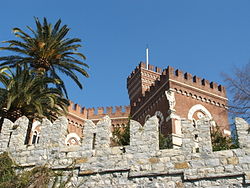
View of the Albertis Castle

Sculpture of Christopher Columbus as a boy by Giulio Monteverde.
The Castello d'Albertis, or D'Albertis Castle is a historical residence in Genoa, north-western Italy. It was the home of sea captain Enrico Alberto d'Albertis, and was donated to the city of Genoa on his death in 1932. It currently houses the Museo delle Culture del Mondo (Museum of World Cultures), inaugurated in 2004.
Description[]
D'Albertis designed the castle in the style of an architectural collage with a Gothic revival appearance inspired by palaces in Florence and castles of Aosta Valley.
Erected between 1886 and 1892 under the supervision of Gothic Revivalist Alfredo D'Andrade, the castle is located on the site of a 13th-century fortified area, which had been reinforced in the 16th century. Alberto not only based his design on the city's foundation, he incorporated and preserved the foundations of the bastion and one of the turrets.[1] Inaugurated for the celebrations of 400 years of Columbus' discover of America, it was the first villa-castle built in Genoa.[2]
From top of the hill of Monte Galletto (or Montegalletto), one of the hills in the district of Castelletto, the castle dominates Genoa with a view of the Ligurian Sea.
Collections[]
The museum includes ethnographic and archaeological findings collected by both Enrico and Luigi Maria d'Albertis during their trips to Africa, America (from Canada to Tierra del Fuego), New Guinea and Oceania. There is a large number of weapons from Sudan and the Zambesi area Chinese spears and European halberds. There are several exemplars of Canadian and American plains indigenous people, made in buffalo and deer leather and covered by porcupine thorns; also findings belonging to the Maya civilization from Honduras are present.
It also exhibits models of ships and yachts, nautical instruments, photographs and the volumes of d'Albertis personal library.
A separate section dedicated to music (the Museo delle Musiche dei Popoli, "Museum of Peoples' Music") exhibits musical instruments from the whole world.
See also[]
- Mackenzie Castle
- List of castles in Italy
- Ascensore Castello d'Albertis-Montegalletto
References[]
- ↑ "The Castle". Castle D'Albertis. Museo dell Culture del Mondo. http://www.castellodalbertisgenova.it/sito%20inglese/frameset.asp?http://www.castellodalbertisgenova.it/sito%20inglese/castello.htm. Retrieved 2008-01-31.
- ↑ ed. Hunt, John Dixon (2007). The Italian Garden: Art, Design and Culture. Cambridge University Press. pp. 323. ISBN 0-521-44353-9. https://books.google.com/books?id=WtzB3_U63QkC&pg=PA232&lpg=PA232&dq=villa+castello+%22d+albertis%22&source=web&ots=UyXPbWL0aw&sig=Ne9vkYebHYFlBx2NpGdqhmdgxdw#PPA232,M1.
External links[]
| Wikimedia Commons has media related to Castello d'Albertis di Genova. |
Coordinates: 44°25′7.4″N 8°55′29.5″E / 44.418722°N 8.924861°E
The original article can be found at D'Albertis Castle and the edit history here.
